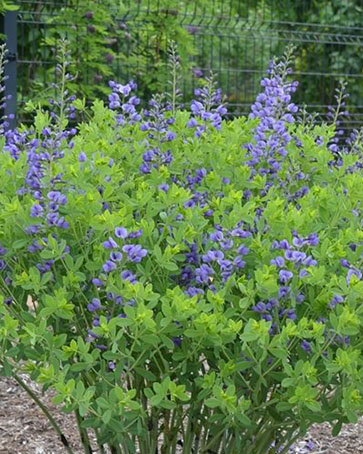Blue Wild Indigo
 Baptisia australis
Baptisia australis
Blue Wild Indigo can provide an early deep blue flare in spring in native plantings where its bushy structure complements summer bloomers.
Introduction
Baptisia australis spends its first few years developing mostly below ground. The branching foliage and blossoms become showier and more developed with each subsequent growing season.
For potted seedlings, this means they may have shorter, possibly floppy stems for the first couple of years before taking on a shrubbier appearance.
Their 4′ height and branching habit make wide spacing advisable in-home landscaping. The dried stems with seed pods are ideal for dried floral arrangements.
Life Cycle
Perennial
Sun Exposure
Full, Partial
Soil Moisture
Medium, Medium-Dry, Dry
Height
2 feet
Bloom Time
July, August, September
Bloom Color
Purple
About the Plant
Blue Wild Indigo is the host plant of three butterfly species, the Frosted Elfin (Callophrys irus), Marine Blue (Leptotes marina), and Orange Sulfur (Colias eurytheme).
Taken to Tumbling
When most people think of tumbleweeds, they think of the Western United States, and picture a dry desert landscape. The plant that most Americans know of as a tumbleweed is the prickly Russian thistle (Kali tragus), a non-native, highly invasive plant, in the amaranth family (Amaranthaceae).
The way a tumbleweed works is that the above ground portion of the plant breaks off and is circular enough to roll. High winds push the light, dry, husk of the plant across the landscape. While the dead plant is spinning the seeds fall off the plant and are dispersed. The Russian thistle is a classic “tumbleweed”, but many other plants use the same strategy to disperse their seeds.
Many species of native Baptisia like white false indigo (Baptisia alba), blue false indigo (Baptisia australis), and yellow false indigo (Baptisia sphaerocarpa) also employ this strategy of dispersal. They are not as round as prickly Russian thistles, but they still accomplish the same thing. The dead plants are top heavy as well, which means that the seeds (if they have not fallen out by the time the plant stops moving) are physically pressed against the ground.
Baptisia species are great for landscaping because they form a small shrub, are perennial, and require no care when established. If you don’t want to worry about the plant blowing into your neighbors’ yards once it becomes a tumbleweed, cut it down in early October and compost the plant. The seeds are easy to save as well, just break open the pods and store the dry seeds.